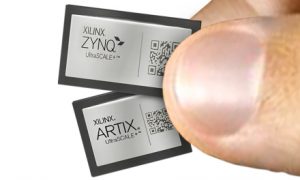26th October 2022
Microchip is aiming at smart metering with a family of microcontrollers and a power-line communication modem IC.
The processors, nominally the PIC32CXMT family, have one or two Arm Cortex-M4F cores – all get a 200MHz application processor, and some get a 240MHz metrology processing core.
The PIC32CXMTSH version in particular (see diagram) gets an ‘energy metering analogue front-end’ (EMAFE) as well, which supports single and dual-phase meters, is compliant with electricity metering standards up to class 0.2 (ANSI C12.20-2002 and IEC 62053-22), and works with the company’s DSP metrology DSP library which is compliant with the same two standards.
This block has five 24bit (102dB dynamic range) ΔΣ ADC measurement channels, and the current channels can support sensing via resistive shunt, current transformer or Rogowski coil without external active components. One of the current channels is assigned to neutral conductor measurement for temper detection.
The voltage reference has a typical drift of 10ppm/°C, said Microchip, “with software correction using factory programmed calibration registers”.
A dedicated 2.8V LDO (3 to 3.6V operation, <2.5mW/channel at 3.3V) cleans the front-end’s power supply.
PIC32CXMTC gets dual cores but no EMAFE, and the PIC32CXMTG only gets one core and no analogue front-end.
What are they aimed at?
“MTSH is targeting specifically single and dual phase metering solutions. MTC, in combination with different external analogue front end, provides an additional level of flexibility and allows us, for example, to address 3phase solutions with shunt sensor,” a Microchip spokesman told Electronics Weekly, adding that MTS parts are largely aimed at residential use, while MTC parts, for which the company has stand-alone AFEs, are for commercial and industrial applications.
Amongst the family, security features in spades: with secure boot and secure key storage coupled with cryptographic and hash hardware acceleration for ECC, RSA, AES128/256 and SHA256/512. An execute-in-place QSPI interface with on-the-fly AES128 encryption is included for future-proofing – memory expansion or changing system requirements.
Also across the family is a segment-style LCD controller, memory protection, I2C, SPI, UART (USART), PWMs, general-purpose 32-bit timers, a 12bit ADC, analogue comparators and a battery backed 1 μA real-time clock.
MPL460 is the power-line modem IC for narrow-band protocols under 500kHz, ITU G.9903 (G3-PLC) and ITU G.9904 (PRIME) included. It has been designed to comply with FCC, ARIB, KN60 and CENELEC EN50065 regulations.
It interfaces with its host microcontroller through a four-wire SP bus, and the signal injection line driver is Class-D to reduce consumption and heat dissipation.
It also has a CPU on-board, woth dedicated power-line coms hardware acceleration.
For security, there is secure boot, AES-128 CMAC for authentication and AES-128 CBC for decryption, as well as fuse programming for decryption and authentication 128-bit keys.
it comes in a 10 x 10mm TFBGA-81, and works over -40 to +85ºC.
Tagged with: Homepage Featured Articles MCU Microchip microcontroller PLC powerline communications power grid smart metering
Your email address will not be published. Required fields are marked *
*
*

Download the Elektra Awards 2022 media pack and book your sponsorship package to be part of the most prestigious awards event celebrating its 20th anniversary this year!
Get the media pack »

Have your say in choosing the most promising UK university research project reported in the last year, from Bristol or ICL to Surrey or Southampton, and robotic fingers to flexible and stretchy supercapacitors…
Cast your vote »
Get our news, blogs and comments straight to your inbox! Sign up for the Electronics Weekly newsletters: Mannerisms, Gadget Master and the Daily and Weekly roundups.

Find out more »
Read our special supplement celebrating 60 years of Electronics Weekly and looking ahead to the future of the industry.
Read the Electronics Weekly @ 60 supplement » 
Read the first ever Electronics Weekly online: 7th September 1960. We’ve scanned the very first edition so you can enjoy it.
Read the very first edition »
Electronics Weekly teams up with RS Grass Roots to highlight the brightest young electronic engineers in the UK today.
Find out more »
Read our special supplement celebrating 60 years of Electronics Weekly and looking ahead to the future of the industry.
Read the Electronics Weekly @ 60 supplement » 
Read the first ever Electronics Weekly online: 7th September 1960. We’ve scanned the very first edition so you can enjoy it.
Read the very first edition »
View All Events
Tune into this Xilinx interview: Responding to platform-based embedded design
Listen to the interview »
Tune into this podcast to hear from Chetan Khona (Director Industrial, Vision, Healthcare & Sciences at Xilinx) about how Xilinx and the semiconductor industry is responding to customer demands.
Listen to the interview »
By using this website you are consenting to the use of cookies. Electronics Weekly is owned by Metropolis International Group Limited, a member of the Metropolis Group; you can view our privacy and cookies policy here.